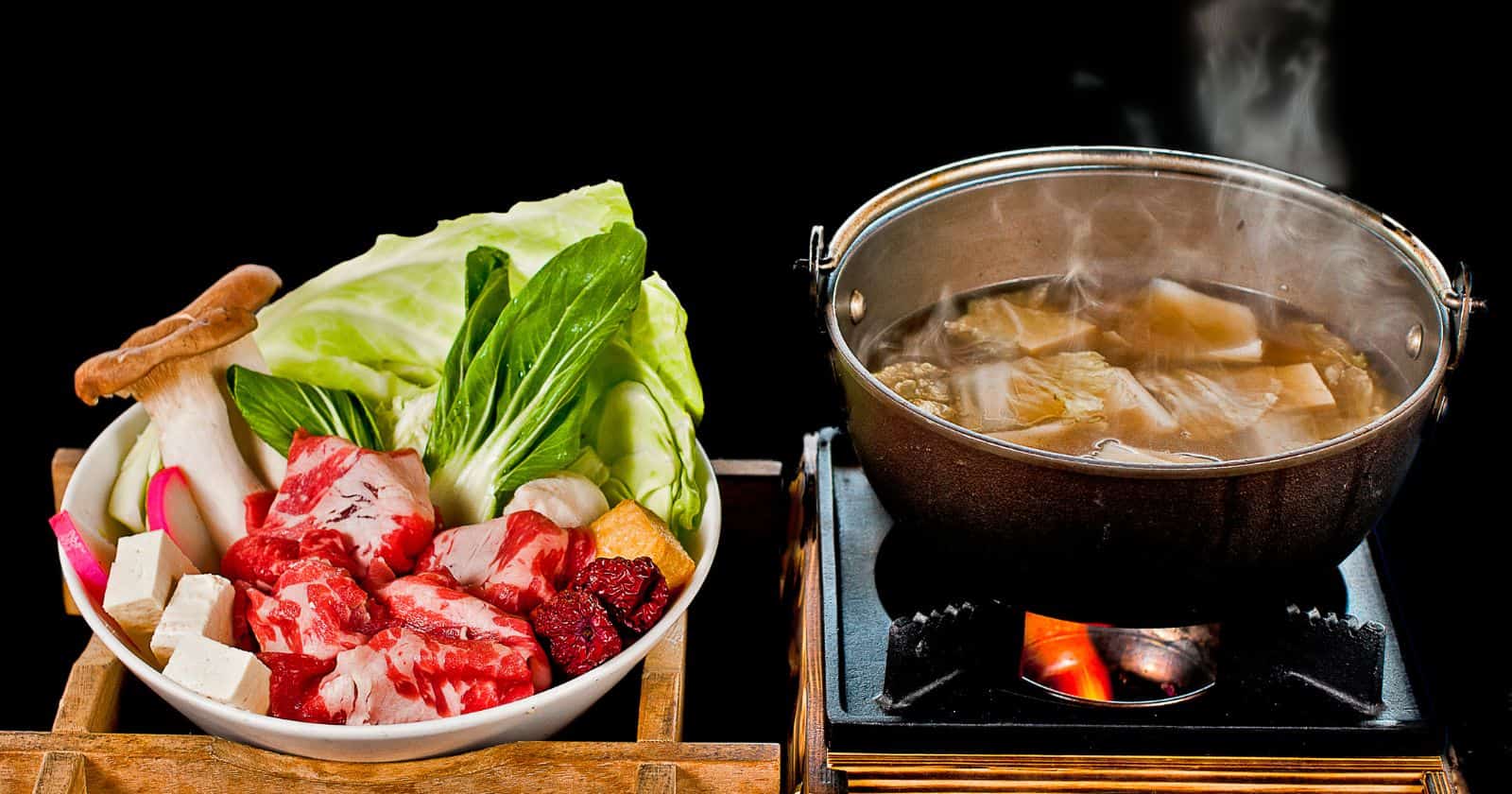Searching for a delicious, interactive dining experience? Craving mouthwatering thinly sliced meats, vibrant vegetables, and flavorful broths? Hot pot could be the perfect meal for you. This popular cooking style lets you create a customized bowl of ingredients cooked right at your table in a simmering pot of broth. Though the basic concept is the same, Chinese and Korean hot pot each have their own unique flavors and ingredients that provide one-of-a-kind culinary adventures.
Chinese hot pot focuses on the yin and yang of bold broths and dipping sauces. The broth is typically spicy, numbing, and full of umami. Dipping sauces like sesame and garlic add another layer of flavor. Thin slices of meat like beef and lamb swirl in the simmering pot, soaking up the broth. Korean hot pot highlights the sweet and spicy. The broth mingles sweet with the kick of gochujang chili paste. Fish cakes, rice cakes, vegetables, and marinated meats like bulgogi beef bathe in the bubbling soup.
Whether you’re craving the mala tingle of Sichuan peppercorns or the sweet kiss of gochujang, hot pot lets you play with flavors and ingredients. The hands-on cooking style makes it a communal dining event centered around the steaming pot. Will your next hot pot experience take you to China or Korea? Let’s dig in and find out!
Broth Basics: Contrasting Foundations
The broth is the heart and soul of any hot pot meal. Chinese and Korean hot pot build their foundation on very different flavors.
Chinese Hot Pot Broths: Yin and Yang
Chinese hot pot broth is all about balance. The classic yin and yang broth base combines two contrasting but complementary flavors:
- Yin – mild, clear broth: This light broth highlights the fresh flavors of the ingredients. It’s typically a basic chicken or vegetable broth.
- Yang – spicy, numbing broth: Mala broth gets its name from the Sichuan peppercorn that makes your mouth tingle. Chili oil and spices add fieriness. The broth is full of umami.
When you dip ingredients in both broths, you get a rollercoaster of flavors. The yin cools your palate while the yang adds punchy
Korean Hot Pot Broths: Sweet and Spicy
Korean hot pot takes a different approach to flavor. The broth mingles sweet with spicy for a highly addictive combination:
- Sweet: Korean hot pot broth often contains fruit juices or purees. Apple, pear, and lemon add fruity flavor. Sugar adds further sweetness.
- Spicy: Gochujang chili paste brings the heat. This fermented condiment made from chili peppers lends a savory, slightly smoky kick. More chili paste means more
spice .
The sweet and spicy broth makes for a highly craveable experience. The gochujang gives even the veggie-filled broth a nice roundness.
Broth Breakdown
Chinese Hot Pot
- Yin/Yang balance
- Mild, clear chicken or veggie broth
- Mala numbing and spicy broth
Korean Hot Pot
- Sweet and spicy
- Fruity flavors like apple and pear
- Gochujang spicy chili paste
Protein Prep: Meat and Seafood Soaking Up Flavor
Filling your hot pot with delicious proteins is a must. Chinese and Korean hot pot use thinly sliced meats and seafoods that soak up the broth’s flavor.
Chinese Hot Pot Proteins
Chinese hot pot takes advantage of quick-cooking sliced meat. Some classic ingredients include:
- Lamb: Thin slices of tender lamb simmer to perfection in seconds.
- Beef: Flavorful slices of beef absorb the broth beautifully.
- Pork: Both fatty slices and lean meat add protein.
- Seafood: Fish balls, shrimp, crab sticks, and calamari are hot pot favorites.
The thin slices allow the meat to quickly soak up all the broth’s lip-numbing and fiery flavors.
Korean Hot Pot Proteins
Korean hot pot uses similar thinly sliced and easy-to-cook proteins. Some essential ingredients are:
- Beef: Marinated bulgogi beef infuses the broth with sweet, savory flavor.
- Pork: Belly pork and Spam add heartiness.
- Seafood: Fish cakes, shellfish, and squid are right at home in the spicy broth.
- Dumplings: Korean dumplings like mandu are perfect for dipping.
The sugars and gochujang help tenderize proteins for a fall-apart texture.
Protein Platter
Chinese Hot Pot
- Thinly sliced lamb, beef, pork
- Fish balls, shrimp, crab sticks
Korean Hot Pot
- Bulgogi beef, pork belly, Spam
- Fish cakes, shellfish, squid
- Dumplings like mandu
Dipping Delights: Sauces and Seasonings
Dipping sauces are key for both Chinese and Korean hot pot. They let you customize your flavor experience dip by dip.
Chinese Hot Pot Sauces
Chinese hot pot sauces balance the broth’s intensity. Essential options include:
- Sesame sauce: Toasted sesame oil, paste, and seeds lend nuttiness.
- Garlic sauce: Minced garlic and chili oil add bite.
- Soy sauce: Salty, umami-rich soy complements the broth.
- Vinegar: Rice vinegar cuts through the broth’s richness.
- Chili oil: Infused oil made from dried chilies provides heat.
Korean Hot Pot Sauces
Korean hot pot focuses more on seasoning the broth itself. But a few essential dipping sauces include:
- Ssamjang: A spicy paste of gochujang, soybean paste, and sesame oil.
- Lime: Fresh lime juice cuts grease and balances sweetness.
- Soy sauce: The classic salty, umami dipping sauce.
- Sesame oil: Nutty toasted sesame oil adds aroma.
- Gochugaru: Flaky Korean chili powder for extra heat.
Dipping Dunks
Chinese Hot Pot Sauces
- Sesame, garlic, soy sauce, vinegar, chili oil
Korean Hot Pot Sauces
- Ssamjang, lime, soy sauce, sesame oil, gochugaru
Veggie Mix-Ins: Crisp Complements
Don’t forget the vegetables! Chinese and Korean hot pot use a variety of crisp, fresh veggies that complement the piping hot broth.
Chinese Hot Pot Veggies
Chinese hot pot veggies tend towards leafy greens, mushrooms, and sprouts:
- Bok choy: The leafy green soaks up broth flavor.
- Napa cabbage: Crunchy leaves wilt in the broth.
- Mushrooms: All types from shiitake to oyster.
- Bean sprouts: Crunchy texture and fresh flavor.
- Spinach: Quick-wilting spinach absorbs broth beautifully.
Korean Hot Pot Veggies
Korean hot pot incorporates veggies like:
- Cabbage: Napa cabbage leaves wrap ingredients to make wraps.
- Mushrooms: Meaty shiitake and oyster mushrooms.
- Onion: Sweet onion soaked in the broth.
- Zucchini: Adds crunch and bright flavor.
- Sweet Potato: Soft, starchy sweet potato soaks up the broth.
No matter which style you choose, filling your hot pot with fresh veggies boosts flavor, nutrients, and satisfaction.
Vegetable Selections
Chinese Hot Pot Vegetables
- Bok choy, napa cabbage, mushrooms, bean sprouts, spinach
Korean Hot Pot Vegetables
- Cabbage, mushrooms, onion, zucchini, sweet potato
Specialty Ingredients: Unique Add-Ins
Beyond the basics, some special ingredients give trademark flair to Chinese and Korean hot pot.
Signature Chinese Hot Pot Ingredients
Look for these specialty items in Chinese hot pot:
- Tofu skins: Silky soft tofu skins soak up broth.
- Meatballs: Seasoned pork and fish meatballs add heartiness.
- Lotus root: The crunchy, lace-like vegetable has a unique texture.
- Tofu: Soft silken tofu drinks in the broth’s flavor.
- Bamboo shoots: Crunchy shoots complement meat.
Notable Korean Hot Pot Ingredients
Korean hot pot features its own signature items like:
- Rice cakes: Chewy rice cakes soften in the broth.
- Glass noodles: Almost disappear in the pot but add starchiness.
- Macaroni: Twisty pasta soaks up flavors.
- Sausage: Spicy rice cake sausage adds heat.
- Ramen noodles: Instant ramen cooks right in the broth.
Specialty Stars
Chinese Hot Pot Specialties
- Tofu skins, meatballs, lotus root, soft tofu, bamboo shoots
Korean Hot Pot Specialties
- Rice cakes, glass noodles, macaroni, sausage, ramen noodles
Cooking Customization: DIY Experience
Part of hot pot’s popularity comes from its DIY cooking experience. Both Chinese and Korean hot pot let you create a personalized meal.
Hands-On Chinese Hot Pot
Chinese hot pot mealtime centers around the simmering pot. The interactive cooking process goes like this:
- Prepare thinly sliced ingredients and sauces.
- Heat broth in a divided pot: yin and yang or all yang!
- Add ingredients like veggies first to briefly cook them.
- Drop in proteins to quickly cook them through.
- Dip cooked items in your choice of sauce combinations.
- Drink up the resulting rich broth at the end!
Interactive Korean Hot Pot
Korean hot pot follows a similar process but with some twists:
- Slice ingredients and make sauce mixes like ssamjang.
- Heat the sweet and spicy broth to a boil.
- Cook meat and veggies to desired doneness.
- Remove cooked items and assemble lettuce leaf wraps with sauce.
- Dip dumplings, noodles, and other carbs right into the broth.
- Drink up the resulting broth, which has soaked up tons of flavor!
Hands-On Fun
Chinese Hot Pot
- Cook ingredients in divided pot of yin and yang broth.
- Quickly cook thinly sliced items.
- Dip items in choice of sauces.
- Drink flavorful broth.
Korean Hot Pot
- Cook meat and veggies in sweet and spicy broth.
- Assemble items in lettuce leaf wraps with sauce.
- Soak noodles and dumplings directly in broth.
- Drink flavorful broth.
Flavor Showdown: China vs. Korea
After looking at the ingredients, cooking process, and flavor profiles, which hot pot style sounds most appealing?
Chinese hot pot highlights the yin and yang broth balance. Its numbing mala and mild clear broth offer a flavor rollercoaster. Sliced meat, leafy veggies, specialty ingredients, and customizable dipping sauces let you curate the experience.
Korean hot pot focuses on the sweet and spicy broth mingling. The fermented gochujang chili paste adds mild heat that tenderizes meat and seafood beautifully. Veggies, noodles, and Korean barbecue meats infuse the broth with amazing flavor.
When it comes down to it, the hands-on cooking process and communal dining experience are at the heart of any hot pot meal. Gathering around a bubbling pot and filling your bowl with favorite flavors makes for a fun and interactive dinner! Can’t decide between Chinese and Korean hot pot? Try them both and double your flavorful fun. Just be prepared to battle over the last bites of tender meat and rich broth!
Frequently Asked Questions About Hot Pot
Q: What are the main differences between Chinese and Korean hot pot broths?
A: Chinese hot pot broth relies on a yin-yang balance of a spicy, numbing broth and a mild, clear broth. Korean hot pot broth combines sweet and spicy flavors, using fruit and gochujang chili paste.
Q: What proteins are popular in Chinese and Korean hot pot?
A: Thinly sliced lamb, beef, pork, fish balls, shrimp, and crab are common in Chinese hot pot. Korean hot pot uses marinated bulgogi beef, pork belly, fish cakes, and dumplings.
Q: What are some signature ingredients in each style of hot pot?
A: Chinese hot pot includes items like tofu skins, meatballs, lotus root, and bamboo shoots. Korean hot pot uses ingredients like rice cakes, glass noodles, macaroni, sausages, and ramen.
Q: How does the DIY cooking process differ between Chinese and Korean hot pot?
A: Chinese hot pot cooks ingredients separately in divided broths. Korean hot pot cooks everything together in one sweet and spicy broth.
Q: Which style of hot pot has more dipping sauces and seasonings?
A: Chinese hot pot offers a wide array of dipping sauces like sesame, soy sauce, garlic, vinegar, and chili oil. Korean hot pot focuses more on seasoning the broth itself.





